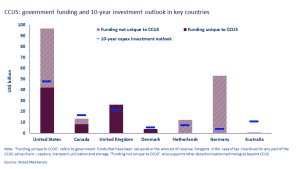Wood Mackenzie, the global leader in providing data analytics and solutions in sustainability and renewable energy has recently rolled out a media statement on cost brackets for expanding CCUS, worldwide. It has predicted an investment of around $196 billion in 2034.
What Does Wood Mackenzie’s 10-Year CCUS Market Forecast Say?
In this analysis, Wood Mackenzie has estimated that global carbon capture capacity can surge up to 440Mtpa and storage capacity will go up to 664 Mtpa. The combined process will require $196bn of total investment by 2034 out of which USD 80B is expected to come from the North American and European Governments.
We have discovered from the report that nearly half of global investment focuses on CO2 capture. The remaining half will be distributed between the transport and storage sectors at $53B and $43B, respectively. Plans are underway to allocate 70% of the total value chain investment in North America and Europe. The report has further emphasized that increasing production projections does not mean that Wood Mackenzie expects carbon capture supply to meet immediate demands. Long-term projects anticipated for 2034 need up to 640 Mtpa of CO2 storage, but expected commissions are lacking by 200 Mtpa.
Hetal Gandhi, APAC CCUS lead with Wood Mackenzie has put her insights in the press release.
She said out of the total announced projects, 71% are in North America and Europe, backed by government incentives. The US Inflation Reduction Act, UK business models, Canada’s Investment Tax Credit, and the Netherlands SDE++ scheme are key contributors. The new EU Industrial Carbon Management Strategy is also expected to boost European projects. She highlighted that China and India are the largest emitters in the Asia-Pacific region but lack proper CCS infrastructure.
Her predictions say that the power and chemical sectors will face significant gaps between demand and supply until 2034. This region needs utmost CCUS upgradation. Notably, China, India, Latin America, the Middle East, and Africa face development constraints due to a lack of policy, regulatory frameworks, and funding support. Government funding for CCUS in key countries totals around $80 billion. The US leads with 50% of the total, followed by the UK at 33% and Canada at 10%.

Using the Investment Effectively, A Wood Mac Study
Following the previous analysis, WoodMac has deep-dived into the role of CCUs in global decarbonization. The research wing has analyzed that some countries are investing in CCUS to decarbonize tough sectors like cement, chemicals, steel, refining, and power. On the other hand, some view CCUS as a long-term decarbonization tool.
Hetal has schemed out some important points to effectively utilize the investment. She believes that CCUS can be most effective when the technology is affordable and sustainable infrastructure is in place for carbon capture and storage. The key focus should be on heavy emitters.
CCUS has garnered significant attention for addressing climate change. Currently, the global CCUS capacity is around 63 Mtpa, which might surge to 1,700 Mtpa by 2050. However, to keep global warming within 1.5 degrees above pre-industrial levels, capacity would need to reach 7,750 Mtpa. Presently, most CCUS projects are targeting the power and gas sector. In the future, CCUS will be crucial for the cement and steel industries, which have limited alternatives to fossil fuels. The production of blue hydrogen will also benefit significantly from CCUS.
Click here to know what 2024 looks like for CCUS, as per Wood Mac.

CCUS Future: Challenges Amid Opportunities
Wood Mac has also outlined some of the challenges of CCUS. The team analyzed that despite progress, CCUS uptake remains limited. Fauzi Said, senior research analyst at Wood Mackenzie, has developed one solution focusing on hub-based storage ecosystems. He said,
“With storage capacities more concentrated than the spread-out capture capacities, hub-based storage ecosystems will evolve especially in Europe and APAC.”
CO2 sequestering costs are high compared to current carbon prices and practically no revenue is in it. Successful projects have managed costs with incentives, but future success relies on effective policies and well-structured carbon pricing schemes. Furthermore, amine-based processes dominate CCUS, which is not enough. They need more advanced technology to capture CO2 cheaply and with scarce carbon concentration. Another challenge is carbon dioxide’s corrosive nature which makes transportation costly and storage challenging. Thus, cost is a significant factor driving the process.
source: Wood Mackenzie
However, in last month’s Wood Mac’s report, we discovered that ExxonMobil has established a strong position in the US CCUS. Wood Mackenzie made a detailed study that figured out, “The company’s US portfolio achieves a weighted average return of 20% in their base case. Some projects yield even higher returns.”
We hope Wood Mackenzie will come up with more updates on global CCUS status and developments very soon.



